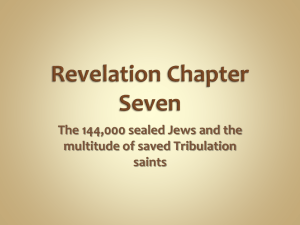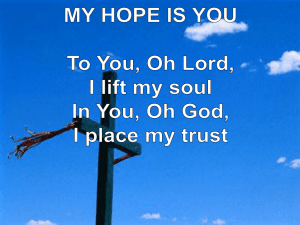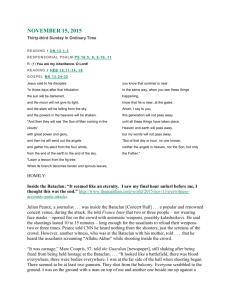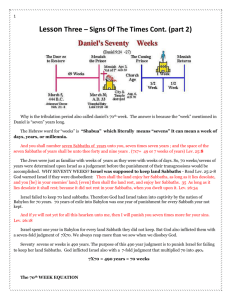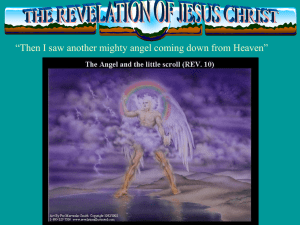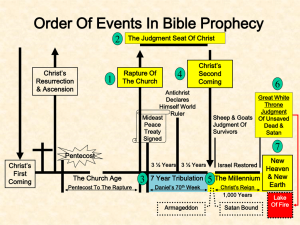Chapter 7 - BibleOne.net
advertisement
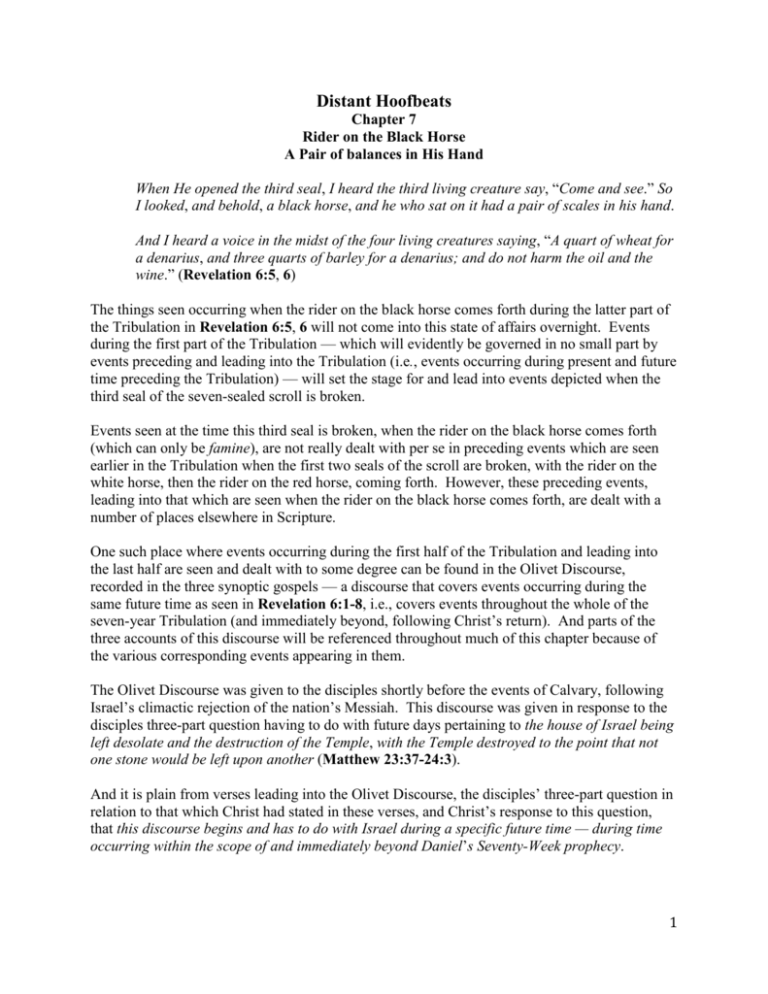
Distant Hoofbeats Chapter 7 Rider on the Black Horse A Pair of balances in His Hand When He opened the third seal, I heard the third living creature say, “Come and see.” So I looked, and behold, a black horse, and he who sat on it had a pair of scales in his hand. And I heard a voice in the midst of the four living creatures saying, “A quart of wheat for a denarius, and three quarts of barley for a denarius; and do not harm the oil and the wine.” (Revelation 6:5, 6) The things seen occurring when the rider on the black horse comes forth during the latter part of the Tribulation in Revelation 6:5, 6 will not come into this state of affairs overnight. Events during the first part of the Tribulation — which will evidently be governed in no small part by events preceding and leading into the Tribulation (i.e., events occurring during present and future time preceding the Tribulation) — will set the stage for and lead into events depicted when the third seal of the seven-sealed scroll is broken. Events seen at the time this third seal is broken, when the rider on the black horse comes forth (which can only be famine), are not really dealt with per se in preceding events which are seen earlier in the Tribulation when the first two seals of the scroll are broken, with the rider on the white horse, then the rider on the red horse, coming forth. However, these preceding events, leading into that which are seen when the rider on the black horse comes forth, are dealt with a number of places elsewhere in Scripture. One such place where events occurring during the first half of the Tribulation and leading into the last half are seen and dealt with to some degree can be found in the Olivet Discourse, recorded in the three synoptic gospels — a discourse that covers events occurring during the same future time as seen in Revelation 6:1-8, i.e., covers events throughout the whole of the seven-year Tribulation (and immediately beyond, following Christ’s return). And parts of the three accounts of this discourse will be referenced throughout much of this chapter because of the various corresponding events appearing in them. The Olivet Discourse was given to the disciples shortly before the events of Calvary, following Israel’s climactic rejection of the nation’s Messiah. This discourse was given in response to the disciples three-part question having to do with future days pertaining to the house of Israel being left desolate and the destruction of the Temple, with the Temple destroyed to the point that not one stone would be left upon another (Matthew 23:37-24:3). And it is plain from verses leading into the Olivet Discourse, the disciples’ three-part question in relation to that which Christ had stated in these verses, and Christ’s response to this question, that this discourse begins and has to do with Israel during a specific future time — during time occurring within the scope of and immediately beyond Daniel’s Seventy-Week prophecy. 1 That is to say, the Olivet Discourse, having to do with the Jewish people and given during the closing days of the sixty-ninth week of Daniel’s prophecy, from a contextual standpoint, can only have to do with events occurring during and immediately beyond the seventieth and final week of this prophecy. These events, having to do with that which will occur during and immediately beyond these final seven years, have to do specifically with God’s climactic dealings with Israel relative to the nation’s centuries of disobedience, followed by the nation’s repentance, preceding the Messianic Era. (Note that there are two words used for “Temple” in the Greek New Testament — Naos and Hieron. The former word [Naos] is more restrictive than the latter [Hieron]. Naos refers to the Temple proper [the Holy Place and the Holy of Holies — the dwelling place of God in the Old Testament theocracy]; and Hieron refers to the whole of the structure, which would include the outer court, porches, buildings subordinate to the Temple proper, and evidently the surrounding wall as well [as seen in Christ’s words (Matthew 24:2; see subsequent comments)]. When Christ taught, it was always in the Hieron [an outer part of the Temple], never in the Naos, into which He could not enter, for He was from the tribe of Judah, not Levi; nor could Christ, with respect to being God, have gone into the Naos at this time, for such an act would have portended, at least after some fashion, a restoration of the theocracy to a disobedient Jewish nation — an impossibility, for such an act would have been contrary to that which is revealed in the Word regarding that which Israel must do prior to the restoration of the theocracy, i.e., Repent! During the present dispensation though, the word Naos is used relative to a Christian’s body being the Temple of the Holy Spirit, though a theocracy is in view only with respect to that which lies in the future for Christians. The destruction of the Temple which Christ referred to in Matthew 24:2 [the Hieron, the whole of that which is viewed as the Temple], aside from being set in a tribulational context, could not possibly have been the destruction by Titus in 70 A.D. [as many Bible students view matters], for part of the Temple wall [the Wailing Wall, the Western Wall] is still standing over 1,900 years later. In the preceding respect, note the all-inclusiveness of Christ’s statement as He addressed the issue — “all these things” [v. 2]. In the Greek text, where antecedents of pronouns are much easier to ascertain than in the English text [because of the highly inflected forms that Greek words take], there is no direct antecedent to the pronoun that Christ used with the word “all” [tauta panta], properly translated “all these things,” with the Hieron in view. The reference could only have to do with everything connected with the Hieron, which could only include the outer wall. Thus, the destruction in view — not one stone left on another — not having occurred in the past, can only refer to a future destruction, a destruction of the Temple about to exist in the land during the days of Antichrist.) In the preceding respect, the Olivet Discourse provides the same overall coverage of Israel and the nations during and immediately beyond the coming Tribulation as seen in the book of Revelation. And the Olivet Discourse is structured exactly like so much of Scripture elsewhere is structured, including the book of Revelation. 2 A Framework, Then Commentary The gospel of Matthew provides the most complete account of the Olivet discourse. And though there are things seen in the other two accounts that are not seen in Matthew’s account, this account will be the one mainly referenced to deal with events culminating in that which are seen when the third seal of the scroll is broken and the rider on the black horse appears. In both Matthew’s account of the Olivet Discourse and in that part of the book of Revelation covering events during the Tribulation and immediately beyond, a brief, overall coverage (a skeletal framework) is given first. This framework, in each instance, is then followed by commentary pertaining to events occurring during time covered by the skeletal framework (sinews, flesh, and skin are then provided to begin covering the previously provided skeletal framework). Genesis begins this way; the gospel of John begins this way; the book of Hebrews begins this way (though after a slightly different fashion, with seven Messianic quotations from the Old Testament, telling the reader, at the beginning, what the book is about); and this same structure, in reality, can be seen numerous places throughout all of Scripture. This is simply one of the ways God has designed His revelation to man, and this revelation must be studied in accord with the way it has been designed and given through “holy men of God” as “they were moved [‘borne along’] by the Holy Spirit” (2 Peter 1:21). And the preceding is just one of a number of primary things about the Word that man must look for and follow if he would come into a proper understanding of this Word, a proper understanding of God’s revealed plans and purposes. As well, God has an affinity for and often uses numbers, types, signs, metaphors, figures of speech, other forms of figurative or spiritual language, parables, etc. Then, in line with the preceding, it matters not what form the God-designed Word may take. This Word is always, at every point, fraught with significance and meaning. And emanating from One who is Omniscient, possessing infinite wisdom and knowledge, who knows the end from the beginning (Ecclesiastes 3:14, 15; Isaiah 48:1ff), how else could one expect the Word to be given? Parallel Places, Comparing Scripture with Scripture Then, as previously seen at the beginning of this chapter, note another way Scripture has been designed, necessitating comparing Scripture with Scripture, allowing Scripture to interpret itself. The same event, or series of events, can often be seen in numerous different places in Scripture, in different books written by different men, though dealt with each time from a different perspective. And the two sections being discussed, in two different books written by two different individuals (Matthew 24 and Revelation 6), dealing with events regarding the Jewish people during the same future time, provide a case in point. 3 The overall coverage of events set forth at the beginning of the gospel of Matthew of the Olivet Discourse (24:4-14) have to do with the same events set forth at the beginning of that part of the book of Revelation covering this same period of time (6:1-8). Matthew approaches the matter from one perspective, and John in the book of Revelation approaches the matter from another perspective. And the two accounts must be studied in the light of one another — comparing Scripture with Scripture — in order to arrive at a more complete picture that God has provided of events that will occur during that time (these two accounts, studied in the light of one another, provide “a more complete” rather than a complete picture, for God has provided other parts of the picture elsewhere; and all must be viewed together in order to see the complete picture). In the preceding respect, Matthew 24:4-8 parallels Revelation 6:1, 2, both covering events during the first half of the Tribulation; and Matthew 24:9-14 parallels Revelation 6:3-8, both covering events during the last half of the Tribulation and immediately beyond (not only having to do with events during the Tribulation but with events surrounding Christ’s return at the end of the Tribulation, preceding the beginning of the Messianic Era). Then, beginning with the commentary part of the Olivet Discourse in the gospel of Matthew (24:15ff), the account has to do entirely with events beginning at the mid-point of the Tribulation and occurring during the last half, leading into Christ’s return and ensuing events at the end of the Tribulation. And these events are provided in the chronological order of their occurrence. The commentary part of the book of Revelation though is different. Beginning in Revelation 6:9 and continuing through chapter nineteen, events throughout the seven-year Tribulation and immediately beyond are provided. And these events, in the overall scope of these chapters (6:919:21), unlike the Olivet Discourse account, are not given in a chronological order (though chronology can be seen numerous times in the different things dealt with throughout these fourteen chapters). (In the preceding respect, note that Christ’s return and ensuing events are seen three different times in this section of the book [Revelation 6:14-17; 14:14-20; 19:17-21]. Or, note where events seen in Revelation 11:15-19 are placed in this section of the book and the place that these events occupy chronologically [placed near the middle of this section, though these events will occur at the end of this section]. Then note sequences of events [such as seen in chapters 11, 12], where chronologies of events can be seen, with the material not only covering events often taking place preceding events seen in earlier chapters but often covering events occurring throughout all of the Tribulation as well.) As previously stated, things seen in the first part of the skeletal framework provided for the Olivet Discourse (vv. 4-8, which deal with the events occurring during the first half of the Tribulation) are not dealt with in the commentary section (vv. 15ff), which covers events beginning at the mid-point of the Tribulation and continues to the time of Christ’s return at the end of the Tribulation (providing the sinews, flesh, and skin for this latter section only). 4 The covering for the first part of the skeletal framework though can be seen elsewhere (e.g., in the books of Daniel and Revelation, along with numerous other sections of Scripture). And attention in this respect, in this chapter, will be given centrally to the books of Daniel and Revelation, rather than certain other books that could be referenced, for several reasons that will become evident. Matthew 24:4-8, dealing with the first half of the Tribulation, calls attention to false Messiahs, wars, rumors of wars, famines, pestilences (plagues, diseases), earthquakes (a shaking of national powers, not earthquakes per se [but nation against nation, kingdom against kingdom]), and the beginning of sorrows (the beginning of birth-pangs). All of the things seen in Matthew 24:4-8 are dealt with after some fashion in the books of Daniel and Revelation. And all of them set the stage for and lead into that which is seen beginning in Matthew 24:15, providing commentary for the previous six verses (vv. 9-14). (The word “pestilences” in Matthew 24:7 [KJV; Gk., loimos] is not found in this verse in many Greek manuscripts, though is found in the Textus Receptus [the main Greek text used for the KJV]. This accounts for its use in the KJV but not in later versions such as the NASB or NIV, versions using Greek texts based on a larger number of manuscripts. However, the word is found in the gospel of Luke’s account of the Olivet Discourse [21:11]. Thus, though the word may or may not be genuine in Matthew’s account, it’s still part of the Olivet Discourse, as Christ gave it. Thus, the KJV rendering will be followed in Matthew 24:7. Also, the word “earthquakes” in Matthew 24:7 [and elsewhere in the New Testament] is a translation of a plural form of the Greek word seismos, meaning “to shake.” The word, in and of itself, has no reference to that which is being shaken. Our English words “seismic,” “seismology,” “seismograph” and other forms of the same word are all derived [in whole or in part] from seismos. Most words in this family of words in the English language are associated with earthquakes; but the words, in and of themselves, as in the Greek language, have no relation to the earth per se [note a cognate form of seismos in v. 13 (seio), translated “shaken”]. The earth is something added to the shaking or agitation, completely apart from the actual meaning of the different words derived from seismos [e.g., “earth” prefixed to “quake,” earth-seismic, “earthquake”]. And in Matthew 24:7, as numerous other places in Scripture where the word seismos is used, an earthquake per se is not in view at all. Rather, contextually, as in this passage, a shaking of national powers is usually in view through the use of this word.) Daniel chapter eleven provides information concerning wars, rumours of wars, a shaking of national powers, and a false Messiah who will appear during this time (vv. 4bff). And the book of Revelation provides the same information about these things, though viewed from another perspective, along with the things having to do with Israel’s birth-pangs during the first half of the Tribulation. (Relative to Israel’s birth-pangs at this time, comparing the Olivet Discourse accounts in the three synoptic gospels, this reference could only have to do with one thing. 5 These birth pangs are mentioned in two of the gospel accounts [Matthew and Mark], but not in the third [Luke]. In both Matthew and Mark, the worldwide proclamation of the gospel of the kingdom is also mentioned, but not so in Luke. Then, in Revelation, Israel in travail results in the nation bringing forth the 144,000 who proclaim this message to the nations [7:1ff; 12:1-5, 17; 14:1-7]. Thus, the inseparable connection between Israel in travail [resulting in the nation bringing forth the 144,000] and the proclamation of the gospel of the kingdom [by the 144,000] is evident by comparing the Olivet Discourse accounts in the three synoptic gospels, along with that which is revealed in the book of Revelation. The 144,000 are brought forth during the first half of the Tribulation [evidently resulting either directly or indirectly from the ministry of the two witnesses — Moses and Elijah —in Revelation 11] and proclaim this message during the last half of the Tribulation [as seen in Revelation 7, 12, 14]. Thus, Israel in travail is mentioned in a verse covering the first half of the Tribulation in Matthew’s Olivet Discourse account [v. 8], and the proclamation of the gospel of the kingdom is mentioned in a verse covering the last half of this period [v. 14]. And this is exactly the way matters are seen in the book of Revelation as well. For additional information in this realm, refer to the author’s books, Prophecy on Mount Olivet, Chapter 2, and The Time of the End, Chapters 21, 26.) Troublous Times Events surrounding the rider on the black horse in Revelation 6:5, 6 center on famine, occurring during the last half of the Tribulation. But note in the Olivet Discourse account in Matthew’s gospel that this famine is seen occurring during the first half of the Tribulation as well (v. 7). It only reaches full fruition during the last half and occupies the totality of that which is stated about events surrounding the rider on the black horse. Then, moving into this latter part of the Tribulation, Matthew 24:9-14 describes Israel’s condition and certain events pertaining to the nation, beginning in the middle and covering the last three and one-half years. And, as previously seen, time-wise, events in these verses have to do with and form a framework for the same events more fully opened up and revealed in the continuing twelve verses (vv. 15-26, furnishing commentary for the previous verses), along with events seen in Revelation 12:6, 13-17. When the man of sin breaks his covenant with Israel (in the middle of Daniel’s seventieth week), the nation will, in an apparent and almost immediate respect, be delivered up for affliction. The mass killing of millions of Jews will then commence; and the Jewish people, at this time, as never before, will begin to be hated by all the nations of the earth (v. 9). Jews themselves during this time, because of existing conditions, will even begin to betray and hate one another; and false prophets will arise among the people, leading many astray (vv. 10, 11; cf. Mark 13:12; Luke 21:16). Scripture relates the matter of an internal turmoil existing among the Jewish people during this time that will bring them to the point of becoming lawless. Their previous “love” for one 6 another, as a result, will grow cold, bringing about dire consequences (v. 12). Betrayal of and hatred for one another, along with the work of false prophets (all among the people themselves), will produce a condition aiding the set goal of the enemy — the beast and his minions, seeking to effect the utter destruction of Israel (cf. Psalm 83:2-8). And this evidently reveals another reason why “unless those days were shortened, no flesh would be saved” (Matthew 24:22). The general plight of the Jewish people during the last half of the Tribulation is actually given in four brief verses (Matthew 24:9-12). And the statement is then made that only those enduring to the end would be saved (v. 13). Contextually, being saved (delivered) by enduring to the end in this verse can only have to do with physical deliverance at the end of the Tribulation. Those Jews (or any others) who survive the afflictions, mass killings, hatred by the Gentiles, and the lawlessness of their own people, will be physically delivered at the end of Daniel’s Seventieth Week. Those who do not will be among the millions of casualties marking this period. Concluding this part of the Olivet Discourse, reference is made to the worldwide proclamation of the gospel of the kingdom. As previously seen, this gospel will be proclaimed throughout the earth by 144,000 Jews during the time described by verses nine through thirteen. The ministry of these Jewish evangelists will thus occur during the darkest hour of human history. This proclamation of the gospel message to the Gentiles worldwide will occur during the reign of Antichrist, amidst all the turmoil, trouble, terror, and conflict within his kingdom; and, as well, it will occur during the time that Satan makes his last, desperate attempt, preceding the Messianic Era, to destroy the nation of Israel. Then, a final attempt by Satan to destroy this nation will occur at the end of the Millennium (Revelation 20:7-9). Wars, Followed by Unparalleled Famine The man who had previously ridden forth on a white horse and then a red horse now appears on a black horse, depicting the result of his previous rides. That depicted by the black horse is famine, something naturally following in the aftermath of war. This will follow in the aftermath of wars occurring during the first half of the Tribulation, and famine being brought to the forefront in connection with these wars. But the event that will really set things off in this and related respects is the seventh head of the beast breaking his covenant with Israel (evidently at the time that he slays the two witnesses in Revelation 11:7). At this time he will desecrate and destroy the Jewish Temple on the Temple Mount, destroy the city of Jerusalem, divide and seek to destroy the very land of Israel itself (treading it under foot, i.e., Gentile domination of the land), and then continue efforts to destroy the Jewish people from off the face of the earth (cf. Joel 3:2; Daniel 9:26; Matthew 24:15ff; Luke 21:20-24). 7 In short, he will seek to destroy anything and everything connected with the Jew — the people, the Temple, the city of Jerusalem, and the land in the Abrahamic Covenant itself. This man will evidently know — at least the one on whose throne he will sit has known for millennia — that to remain on the throne, the Jewish nation and everything connected with it must be destroyed. Is it any wonder that famine is seen existing throughout the earth at this time! In actuality, as seen in the text, the greatest famine in the history of the earth will grip the world at this time, for the simple reason that the greatest persecution in the history of the Jewish people will have befallen the nation. And this famine will be completely in keeping with the persecution and the God-established laws of the harvest, for man does not violate that which God has established and decreed without suffering the consequences. (A person always reaps what he sows, and he always reaps more than he sows, with a period of time lying between the sowing and the reaping. A sown grain of wheat, over time, produces a stalk of wheat with many grains; a sown apple seed, over time, produces an apple tree with many apples, etc. Everything, over time, reproduces “after its kind,” with that which is reproduced is always more than that which was sown [Genesis 1:11, 12; Galatians 6:7]. These are God-established laws that cannot change. The man depicted by a rider on a white horse, then a red horse, then a black horse, and then a pale horse will not be able to circumnavigate the laws of the harvest that God has established. This man will sow the wind, and he will reap the whirlwind [Hosea 8:7].) The man riding the black horse is seen with a pair of balances in his hand, and the price is given for a specified amount of food. A “penny [a day’s wage when this was written]” would purchase a “measure [about a quart] of wheat” or “three measures of barley.” That is to say, in that coming day, it will cost a day’s wage for a minimal amount of food. The thought appears to be that life will be reduced to the barest of necessities — food to sustain life, and a fight for survival. The appearance of the man with a pair of balances, in connection with weighing and measuring food, would itself show a scarcity of food rather than a plentiful supply. Regardless of that which is in view (gold, silver, food, etc.), measures and weights are seen in Scripture in connection with the thought of scarcity, not with the thought of plenty (cf. Leviticus 26:25, 26; 1 Chronicles 22:14; 28:14, 16, 17; John 3:34; Ephesians 4:7). The mention of two types of food — wheat and barley — would also show something about the scarcity of food in that coming day. Both wheat and barley are foods consumed by humans; but wheat is preferred, with barley appearing in less plenteous times (2 Kings 4:42; John 6:9). Aside from the preceding, barley during Solomon’s day was used as food for horses (1 Kings 4:28); and the Romans, at times, substituted barley for wheat as a form of military punishment among troops. 8 Then, after dealing with the preceding in verse five and the first part of verse six, that which is stated about events having to do with this famine closes with the expression, “do not harm the oil and the wine (Revelation6:6b). “Oil and wine” are seen in Scripture in connection with blessings (cf. Deuteronomy 11:14; 28:51; 2 Chronicles 2:10, 15). And it is that which is seen in connection with “oil and wine” (blessings) which was taken from Israel because of their continued disobedience over centuries of time but will one day be restored to the nation following repentance (cf. Joel 1:10; 2:19; 3:17ff). In this respect, the expression at the end of that which is stated about the rider on the black horse, “do not harm the oil and the wine,” could only be seen in a contextual respect as having to do with God’s dealings regarding Israel concerning limitations, with a view to the future. That is to say, through the severity of this famine, along with all the other things occurring at this time, God will remain true to His Word and deliver His people out of this time, ultimately restoring to the nation that is seen by and through the use of “oil and wine.” The matter will be similar to the account of God dealing with Satan in relation to Job. God gave all that Job possessed over into Satan’s hands, with one exception — Job’s life (Job 1:12; 2:6). Satan then acted accordingly, trying to take Job down, seeking to make Job curse God to His face (Job 1:11; 2:7ff). Satan took everything that Job possessed, including his family, but could not succeed in that which he had sought to bring about. In the end, Satan could not hurt “the oil and the wine.” In the end, God restored Job and blessed him above measure, with a new family, new and greater possessions, and new-found happiness (Job. 42:12ff). And the preceding, from a textual and contextual standpoint, could really be the only way that the expression, “do not harm the oil and the wine,” could be looked upon in Revelation 6:6. It could only have to do with God, during the Tribulation, bringing Israel (through famine, among other things) to a similar place as Job was brought (the loss of everything but life itself). Then, in the end, “the oil and the wine” will remain unhurt. In the end, Israel will find herself blessed above measure, exactly as seen with Job in the end. The World Today, in That Coming Day Evident from the times in which we live and that which can be seen occurring all around us (living at a time very near the end of the dispensation, with lawlessness, civil unrest, homosexuality, etc. running rampant, and unrest in the Middle East existing on a scale heretofore unseen), events occurring in the world today can only be, at least after some fashion, setting the stage for that which will be occurring when the Tribulation begins. And, as seen in that which Christ revealed to His disciples in the Olivet Discourse, wars, famines, and pestilences (plagues, diseases) are things that will mark the first part of the Tribulation (Matthew 24:7; Luke 21:11), with famine singled out as a major factor during the last half of the Tribulation. But, with famine of the nature that will exist in those days, other 9 things — plagues, diseases and all types of unrest — could only continue from the first half of the Tribulation and accompany the famine. And the world is rapidly moving in this direction on both fronts — famine, with the accompanying plagues, diseases and unrest. Famine is already a major problem in certain parts of the world, and, with the passage of time, it can only increasingly become a major problem worldwide. An increase in food production during modern times has not kept pace with the increase in world population. Global population has doubled during about the past half century, and it is expected to double again during a comparable length of time in the future. With the passing of each day, about one-quarter million people are added to the about six and one-half billion inhabitants of the earth. (A doubling of the population is not a doubling of a previous number but a doubling of the current number, seen on an exponential scale. That is, three billion doubling to six billion [near the current world population], six billion doubling to twelve billion [projected population in about another fifty years or so], twelve billion doubling to twenty-four billion [projected population in some 100 years or so], etc. Of course, the time for this to occur on the projection does not exist. We are too near the end of the Man’s Day. It has been given only to illustrate what has been occurring with the world’s population in this exponential manner over the past 100 or so years and why the world is increasingly finding itself with more and more problems, which will be brought to a head during the coming Tribulation.) Agriculture, along with a number of different things related to agriculture, could only top the list of problems that man is faced with today. And, as previously stated, agriculture, over the years, has not kept pace with the population increase. And other major problems exist that are either directly or indirectly related to agriculture. For example, supplies of fresh water and quality soil — vitally necessary for agriculture — are both being depleted and/or polluted. Then there are the natural resources that are being depleted, some vitally necessary for the support of even human life itself. And the list could go on and on and on. For years, water has been pumped from underground reservoirs much, much faster than it has been replenished (i.e., water for farmland use pumped by thousands of wells from the Ogallala Aquifer lying beneath the surface of western Texas, western Kansas, and much of Nebraska forms one such usage), and wells are continually having to be dug deeper and deeper as the water levels continue to drop lower and lower (about 80 percent of water usage worldwide today is for agriculture alone). And it is evident that water usage after this fashion can’t continue indefinitely. Matters are already far beyond the point of no return; and though major changes are being worked on, proposed, and even worked out in some instances, the inevitable can only occur with the passing of time — an increasing non-availability of fresh water for crops that the world has to have, 10 resulting in an increasing non-availability of food, resulting in increasing unheard-of prices for the food that will be available, resulting in an increasing famine on a level heretofore unseen in the world. Then, along with the preceding, there will be pestilences (plagues and diseases), along with the pollution of existing land and water. And, in the light of things occurring in the world today, it would take little imagination to see how numerous things already in place could very well lead into the first part of the Tribulation and then escalate, accompanying the corresponding famine, during the latter part of the Tribulation. Super-strains of viruses have already appeared, some which cannot be controlled, due in no small part to the abuse of drugs to control diseases throughout past decades. Then there are current diseases such as AIDS, Ebola, etc. When this is all put together, one has a very similar picture, if not an exact picture, of escalated conditions during the Tribulation following that which is seen occurring after the rider on the black horse makes his appearance. Whether or not present conditions as previously described will play major roles in how conditions will evolve and become during the Tribulation can, of course, not be stated for certain. The matter has been presented in this manner only to show that the world is quite ripe for that which Scripture states is about to occur. That is to say, as previously seen, conditions that could very well result in prophesied future conditions are currently in place. Then, something else needs to be considered. Time is fast running out. As previously stated, we are almost at the end of Man’s Day. We are almost at that time when these prophesied events will begin occurring. 1) How Bad Will It Really Get? During that future time, with famine (among other connected or related things) escalating and running rampant, exactly how bad will conditions get? The answer to the question is that God is going to allow conditions in that coming day — “the time of Jacob’s trouble” (Jeremiah 30:7ff) — to get as bad as it takes to bring the Jewish people to the place of repentance. That which happened in Europe during the reign of the Third Reich — the extreme persecution of the Jews throughout Europe and the extermination of 6,000,000 in the death camps — wasn’t enough to effect the nation’s repentance. What will it take to bring about their repentance? What will it take to bring this nation to the place where they will call upon the God of their fathers? It will take EXACTLY the things that the Word reveals are about to occur in the world — NOTHING LESS! And that’s how bad things are going to get, with the nations of the earth caught up in this right along with Israel. 11 During the Tribulation, particularly during the last half, two-thirds of the Jewish population of the earth will die (die because of hunger or accompanying plagues or diseases, or be slain at the hands of the beast and those who do his bidding). There are statements pertaining to all of this in a number of prophecies, but in two books, the two-thirds number is given; and in one book a division of the two-thirds is given, showing part dying because of famine and pestilences and the other part dying, either directly or indirectly, at the hands of the beast. Note the passage usually quoted pertaining to the two-thirds being slain, from Zechariah: “And it shall come to pass in all the land,” says the LORD, “That two-thirds in it shall be cut off and die, but one-third shall be left in it: I will bring the one-third through the fire, will refine them as silver is refined, and test them as gold is tested. They will call on My name, and I will answer them. I will say, ‘This is My people’; and each one will say, ‘The LORD is my God.’” (Zechariah 13:8, 9) Then note what Ezekiel has to say about the same matter, providing additional information: Thus says the Lord GOD: “This is Jerusalem; I have set her in the midst of the nations and the countries all around her. She has rebelled against My judgments by doing wickedness more than the nations, and against My statutes more than the countries that are all around her; for they have refused My judgments, and they have not walked in My statutes.” Therefore thus says the Lord GOD: “Because you have multiplied disobedience more than the nations that are all around you, have not walked in My statutes nor kept My judgments, nor even done according to the judgments of the nations that are all around you” – Therefore thus says the Lord GOD: “Indeed I, even I, am against you and will execute judgments in your midst in the sight of the nations. And I will do among you what I have never done, and the like of which I will never do again, because of all your abominations [a statement that can place this during only one time — during the future Tribulation]. Therefore fathers shall eat their sons in your midst, and sons shall eat their fathers; and I will execute judgments among you, and all of you who remain I will scatter to all the winds. 12 Therefore, as I live,” says the Lord GOD, “surely, because you have defiled My sanctuary with all your detestable things and with all your abominations, therefore I will also diminish you; My eye will not spare, nor will I have any pity. One-third of you shall die of the pestilence, and be consumed with famine in your midst; and one-third shall fall by the sword all around you; and I will scatter another third to all the winds, and I will draw out a sword after them. Thus shall My anger be spent, and I will cause My fury to rest upon them, and I will be avenged; and they shall know that I, the LORD, have spoken it in My zeal, when I have spent My fury upon them.” (Ezekiel 5:5-13). Note how bad things will become for the Jewish people, solely because of the famine and accompanying pestilence. And this could only exist among the nations as well, though not to the extent as it will be seen among the Jewish people. The Gentiles will have access to at least some food, but this will not be the case with Israel. Conditions in the world for the Jewish people during the last half of the Tribulation will become far, far worse than conditions became for them in Nazi Germany and much of the remainder of Europe immediately preceding and during World War II. The Jewish people during this time will not be able to purchase food; nor will they be able to barter or sell their goods (Revelation 13:16, 17), with perhaps food in view. This is the “why” of that which is stated in Matthew 25:31-46 — which has to do with the Gentiles’ treatment of the Jewish people during the Tribulation and that which will result when Christ returns and deals with these Gentiles on that basis. Saved Gentiles at the end of the Tribulation will be judged on one basis alone, with a position in the kingdom in view. They will be judged solely on the basis of their treatment of the Jewish people during the Tribulation, which can only be in the realm of helping or not helping them in different fashions — providing or not providing food, shelter, necessities of life, etc. This is also the “why” of that which is stated in verse ten of the previously quoted section of Scripture from Ezekiel chapter five. As seen in this verse, food will be so scarce in the camp of Israel in that coming day that cannibalism will exist. Matters in this respect, as clearly stated in Scripture, will be brought to the place that even those in a family will slay and eat other members of that family. Impossible? Hardly! Not only has this happened in history but Scripture clearly states that it will happen again, during a time in the immediate future when conditions will become so severe (famine, among other things) that apart from the Lord’s intervention, the human race could not survive those days (Matthew 24:22). But Israel brought to the place of repentance through this persecution will effect the Lord’s intervention once again in man’s affairs. 13 During Elijah and Elisha’s day, conditions surrounding famine became so severe that an ass’ head and dove’s dung were sold for pieces of silver; and, as well, there is an account of a mother killing and boiling a son for food (2 Kings 6:24-31). And the Tribulation and time immediately following will, so to speak, be Elijah’s day again, when he appears, with Moses, here on earth in the land of Israel during the first half of the Tribulation, and then accompany Christ to the earth at the time of His return following the Tribulation. And famine, of a similar type seen during his day in history will be seen again during his day yet future (cf. Leviticus 26:29; Deuteronomy 28:53). Then the preceding is just part of a much larger picture. The death of two-thirds of the world’s Jewish population would be little more than about 9,000,000 as the Jewish population of the earth presently stands. But what about the billions comprising the remainder of the earth’s population? At least one-fourth of these individuals are going to die during or immediately following this time as well (cf. Revelation 6:8-10; 7:9, 13, 14; 9:18; 11:13; 13:7). Why? How? Hunger, plagues, diseases would address part of the matter; judgments during the Tribulation would address other parts; mandatory beast worship, taking his mark would address more… And, as seen, many going through this time will not make it all the way through. Only the ones enduring until the end will be delivered out of this time (Matthew 24:13). Inconceivable conditions will exist in that day (famine, plagues, diseases, cannibalism); the government of the earth will be of an inconceivable form (things seen in ISIS and/or Al-Qaeda today could be no more than a forerunner or prelude to something far worse existing in that day); and the resulting carnage that will follow (consisting of billions of people), as well, can only be looked upon in an inconceivable fashion. During Joseph’s day while in Egypt, in the book of Genesis, there were seven years of plenty that were followed by seven years of famine. And the years of famine became so severe that the preceding years of plenty were not even remembered (Genesis 41:29-31, 53, 54). And the preceding — a type of that about to occur, showing two complete periods of time by the two sevens of years — relates exactly how conditions presently exist in that which “Egypt” typifies, in the world (during the time of plenty), and how conditions will shortly become in the world (during the time of famine). We’re living during the time of plenty, but this time is about to end, with the time of famine to follow. And the latter, in complete keeping with the type, will be so severe that the former will not even be remembered. You don’t want to be here (a time which can’t possibly be very far away)! 14 If saved, you won’t be here. You will have been removed into the heavens, with ensuing events occurring there (the judgment seat of Christ and things beyond). But, if unsaved at the time when the Church is removed, you will be here, with ensuing events as well (events as previously described). 2) Then, One Other Thing to Consider As previously stated, the Church (all Christians — the living at that time, and the dead from throughout the dispensation, resurrected) will be removed from the earth into the heavens preceding the Tribulation; and Israel, along with the Gentile nations (billions of people, evidently from the times in which we live, people alive today), are going to go through this time of unparalleled trouble, suffering, death . . . . But think for a moment about the scene in the world once all Christians have been removed. In most countries, it will make little to no difference (e.g., Moslem countries, or countries with only a sprinkling of Christians). But note a country such as the United States, where millions of Christians can be found working and heavily engaged in almost every conceivable type job. What’s going to happen when the individuals holding all of these jobs, without any advance warning, are suddenly no longer here? How long will the power stay up, the water keep running, the gasoline pumps keep working, the grocery stores remain open — and the list could go on and on — when key individuals in all these jobs are suddenly no longer here to provide service and help? Only one thing could possibly exist in much of the country, particularly in large cities, for at least a time — Mass Chaos! And how will this possibly play into aiding or helping bring matters to pass in order to correspond with the manner Scripture describes these things existing in the world during this future time? Of course, we can’t know the answers to these questions, but the sudden removal of millions of people could conceivably have a major part in the changes of existing conditions in this country. This is perhaps something to consider, along with that which Scripture reveals, as we move on to the rider on the pale horse in the next chapter. As bad as conditions will become by and through events depicted by the rider on the black horse, it is the rider on the pale horse who will bring things to an apex, with the heavens finally opening and a quite different Rider on a white horse than the one seen in Revelation 6:1, 2 comes forth to bring things to an end (Revelation 19:11-21). 15
